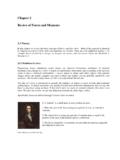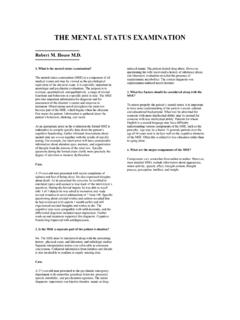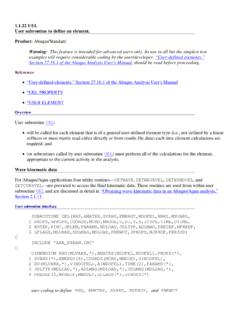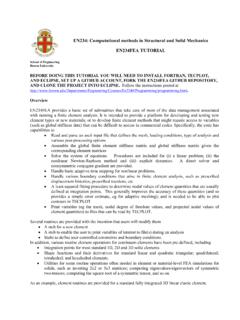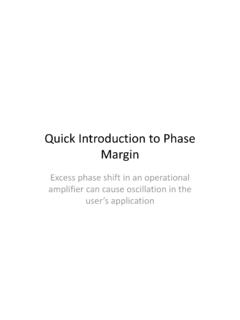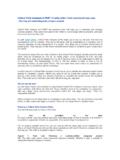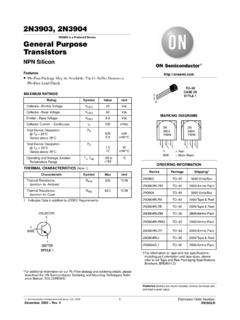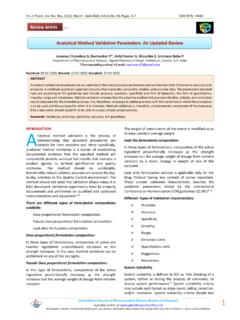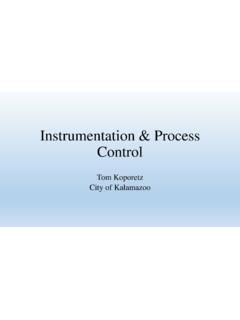Transcription of V oltammetric T echniques - Brown University
1 709 Chapter 37 Voltammetric TechniquesSamuel P. KounavesTufts UniversityDepartment of ChemistrySummary General Uses Quantitative determination of organic and inorganic compounds in aqueous and nonaqueous solutions Measurement of kinetic rates and constants Determination adsorption processes on surfaces Determination electron transfer and reaction mechanisms Determination of thermodynamic properties of solvated species Fundamental studies of oxidation and reduction processes in various media Determination of complexation and coordination valuesCommon Applications Quantitative determination of pharmaceutical
2 Compounds Determination of metal ion concentrations in water to sub parts-per-billion levels Determination of redox potentials Detection of eluted analytes in high-performance liquid chromatography (HPLC) and flow in-jection analysis710 Handbook of Instrumental Techniques for analytical Chemistry Determination of number of electrons in redox reactions Kinetic studies of reactionsSamplesStateSpecies of interest must be dissolved in an appropriate liquid solvent and capable of being reduced oroxidized within the potential range of the technique and electrode material.
3 AmountThe amounts needed to obtain appropriate concentrations vary greatly with the technique. For example,cyclic voltammetry generally requires analyte concentrations of 10 3 to 10 5 M, whereas anodic strip-ping voltammetry of metal ions gives good results with concentrations as low as 10 12 M. Volumes mayalso vary from about 20 mL to less than a microliter (with special microelectrode cells).PreparationThe degree of preparation required depends on both the sample and the technique. For determinationof Pb(II) and Cd(II) in seawater with a microelectrode and square-wave anodic stripping voltammetry(ASV), no preparation is required.
4 In contrast, determination of epinepherine in blood plasma at aglassy carbon electrode with differential pulse voltammetry (DPV) requires that the sample first be pre-treated with several reagents, buffered, and TimeOnce the sample has been prepared, the time required to obtain a voltammogram varies from a few sec-onds using single-sweep square-wave voltammetry, to a couple of minutes for a cyclic voltammogram,to possibly 30 min (or more) for a very-low-concentration ASV Substance must be oxidizable or reducible in the range were the solvent and electrode are elec-trochemically inert.
5 Provides very little or no information on species identity. Sample must be dissolvedAccuracyAccuracy varies with technique from 1 to 10%.Sensitivity and Detection LimitsVoltammetric Techniques711 Detection limit varies with technique from parts per thousand to parts per or Related Techniques Other electroanalytical techniques may provide additional or preliminary information for elec-trochemical properties. Simultaneous use of spectroscopic methods can identify species undergoing reaction. Liquid chromatography is often used to separate individual analytes before , the branch of electrochemistry we now call voltammetry developed from the discovery ofpolarography in 1922 by the Czech chemist Jaroslav Heyrovsky, for which he received the 1959 NobelPrize in chemistry.
6 The early voltammetric methods experienced a number of difficulties, making themless than ideal for routine analytical use. However, in the 1960s and 1970s significant advances weremade in all areas of voltammetry (theory, methodology, and instrumentation ), which enhanced the sen-sitivity and expanded the repertoire of analytical methods. The coincidence of these advances with theadvent of low-cost operational amplifiers also facilitated the rapid commercial development of relative-ly inexpensive common characteristic of all voltammetric techniques is that they involve the application of apotential (E) to an electrode and the monitoring of the resulting current (i) flowing through the electro-chemical cell.
7 In many cases the applied potential is varied or the current is monitored over a period oftime (t). Thus, all voltammetric techniques can be described as some function of E, i, and t. They areconsidered active techniques (as opposed to passive techniques such as potentiometry) because the ap-plied potential forces a change in the concentration of an electroactive species at the electrode surfaceby electrochemically reducing or oxidizing analytical advantages of the various voltammetric techniques include excellent sensitivity witha very large useful linear concentration range for both inorganic and organic species (10 12 to 10 1 M)
8 ,a large number of useful solvents and electrolytes, a wide range of temperatures, rapid analysis times(seconds), simultaneous determination of several analytes, the ability to determine kinetic and mecha-nistic parameters, a well-developed theory and thus the ability to reasonably estimate the values of un-known parameters, and the ease with which different potential waveforms can be generated and smallcurrents chemists routinely use voltammetric techniques for the quantitative determination of avariety of dissolved inorganic and organic substances. Inorganic, physical, and biological chemistswidely use voltammetric techniques for a variety of purposes, including fundamental studies of oxida-tion and reduction processes in various media, adsorption processes on surfaces, electron transfer andreaction mechanisms, kinetics of electron transfer processes, and transport, speciation, and thermody-namic properties of solvated species.
9 Voltammetric methods are also applied to the determination ofcompounds of pharmaceutical interest and, when coupled with HPLC, they are effective tools for theanalysis of complex Handbook of Instrumental Techniques for analytical ChemistryHow It WorksThe electrochemical cell, where the voltammetric experiment is carried out, consists of a working (in-dicator) electrode, a reference electrode, and usually a counter (auxiliary) electrode. In general, anelectrode provides the interface across which a charge can be transferred or its effects felt. Because theworking electrode is where the reaction or transfer of interest is taking place, whenever we refer to theelectrode, we always mean the working electrode.
10 The reduction or oxidation of a substance at the sur-face of a working electrode, at the appropriate applied potential, results in the mass transport of newmaterial to the electrode surface and the generation of a current. Even though the various types of vol-tammetric techniques may appear to be very different at first glance, their fundamental principles andapplications derive from the same electrochemical theory. Here we summarize some of the electro-chemical theory or laws common to all of the voltammetric techniques. Where necessary, more spe-cific details are given later under the discussion of each TheoryIn voltammetry, the effects of the applied potential and the behavior of the redox current are describedby several well-known laws.
